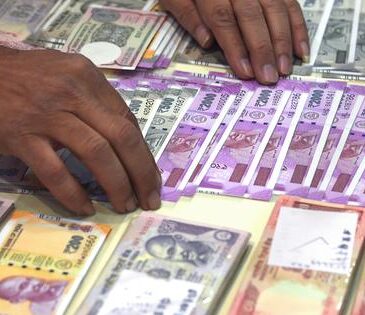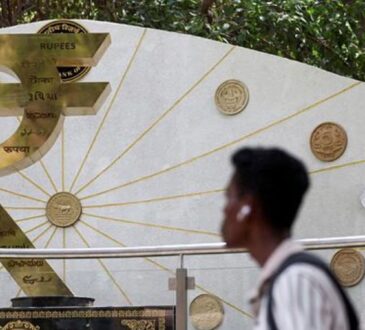Beyond trade, the move could disrupt currency markets, capital flows, and corporate strategies worldwide. While India faces fresh challenges, the shift may also create unexpected opportunities in an evolving global trade landscape.
Read this | Trump’s tariff strike: India hit with 26% duty as trade war escalates
The tariffs provide India with greater clarity on sectoral impacts and corporate cash flows. However, Indian businesses must now shift focus from cost competitiveness to innovation, said Sachchidanand Shukla, group chief economist at Larsen & Toubro.
“The INR (Indian Rupee) could remain under pressure with a global risk-off, but the bigger risk to monitor is any aggressive yuan devaluation—that will be the joker in the pack,” Shukla said.
A protectionist push
Trump’s move seeks to counter what he calls unfair trade practices.
The 26% tariff rate imposed on Indian goods stems from the US administration’s claim that India levies an average 52% tariff on US imports. Trump referred to this as a “discounted” reciprocal tariff—essentially imposing half of what the US believes India charges on its products.
Read this | Are Trump’s tariff rates made up? Here’s how they may have been calculated
The move signals an increasingly protectionist stance, with potential ripple effects across global trade and currency markets.
For India, the challenge is twofold: managing immediate disruptions while positioning itself for long-term gains. With sectoral impacts now clearer, businesses must transition from cost-driven competition to innovation-led growth.
A Bernstein report, dated 3 April, suggests India is unlikely to escalate the situation into a full-blown trade war, opting instead for negotiations. While Indian markets may react negatively in the short term, Bernstein remains optimistic about macroeconomic recovery in the second half of the year.
A potential US-India trade agreement could be a long-term positive, though risks remain due to a slowing US economy and potential recessionary pressures.
“Items like apparel and auto parts will see major tariff hikes, but India seems protected from a competitive point of view, as tariffs on several South Asian economies that compete with India on these items are even higher,” the report noted.
“If at all, India can gain from China’s loss, which by some measures now stares at 54% tariff if the existing 20% is added on top of the additional 34%. The big loss will eventually come in the form of US discretionary spending, which can have medium-term consequences for the economy if the tariff war heats up,” it added.
Currency market fallout
The US dollar is likely to strengthen as investors seek safe-haven assets in response to higher trade barriers. The Federal Reserve’s monetary policy and broader macroeconomic indicators will further influence its trajectory.
Read this | In charts: How exposed is India to Trump’s reciprocal tariffs?
A stronger dollar could partially offset tariff impacts on India but would also raise its import bill—particularly for crude oil and other essentials—potentially fuelling inflation.
Higher tariffs will drive up import costs, with US imports accounting for about 10% of GDP. A 7% increase could translate into a direct 0.7% inflationary impact, keeping the Federal Reserve cautious on interest rates, said Madan Sabnavis, chief economist at the Bank of Baroda.
Still, India may not be insulated from currency fluctuations. As the dollar strengthens, all major currencies—including the rupee—will likely depreciate, making rupee management a key challenge, Sabnavis said.
Beyond trade, capital flows could also be affected.
“In case there are subsidies given for production, there can be a flight of capital from other countries including India to the US to capitalize on the opportunity. So outward investment will need to be monitored. But this may not happen immediately as corporations will weigh options including the opportunity in India,” he said.
A weaker rupee would have a greater impact on wholesale inflation than consumer inflation, potentially raising the Wholesale Price Index (WPI) by 0.3-0.5% over the medium term, Sabnavis noted.
At the same time, a depreciating rupee could boost remittance inflows. Indian expatriates—particularly those in the US—may find it more lucrative to send money home.
According to the Reserve Bank of India (RBI), US remittances constitute a significant portion of India’s foreign exchange reserves. Any fluctuations in currency values could affect these inflows.
In FY24, the US became the largest source of remittances to India, contributing 28% of the total and surpassing the Gulf nations. India’s total remittance inflows reached a record $118.7 billion, more than doubling from $55.6 billion in FY11, RBI data showed.
A weaker rupee presents a double-edged sword. While it enhances India’s export competitiveness, it also raises the cost of imports, adding inflationary pressure on the economy.
The RBI’s role
As reciprocal tariffs reshape trade and currency dynamics, the Reserve Bank of India will play a key role in stabilizing the economy.
The RBI is expected to provide monetary support with another rate cut in its April 2025 policy meeting, offering some relief to businesses hit by tariffs.
“Although we believe that (US) trade partners including India will continue to negotiate for a better deal in the upcoming months through diplomatic channels, we expect RBI to deliver another 25 bps (basis points) rate cut in April-25, as elevated tariffs would prove to be a drag on domestic growth,” JM Financial said in its report on reciprocal tariffs dated 2 April.
However, as India navigates these headwinds, policymakers must strike a balance between trade protection, exchange rate stability, and inflation control to sustain economic growth.
“The Indian government’s approach has been collaborative till now, which is evident in the duty reduction in the budget announcements in February 2025. Moreover, India avoided any retaliatory moves against the US, unlike in the case of China and the European Union,” the JM Financial report added.
In an interview with Mint in November, NITI Aayog member Arvind Virmani suggested that President Trump’s proposed import tariffs could ultimately benefit India by accelerating supply chain shifts away from China. A stronger dollar, he argued, could mitigate the economic impact of tariffs.
“When a country imposes, let’s say, a 10% tariff uniformly on every item it imports, which increases tariff protection by 10% on every item uniformly, economic theory tells you the exchange rate will just adjust to offset it, more or less. So there is zero effect on outsiders,” Virmani had said, adding that while theory suggested a full offset, even at 80-90%, the impact on outsiders will be marginal and not a major concern.
Despite the risk of market stagnation in the US, India remains more competitive than China and Vietnam due to lower tariff rates, said Bipin Sapra, partner, Tax and Trade Policy, EY India.
Also read | Mint Snapview: Many countries will retaliate against Trump’s tariffs. India must not.
“Some items have been left out of the imposition, prominent being pharmaceuticals, copper, certain chemicals and semiconductors. No new tax has been imposed on auto components, steel and aluminium products, on which tariff has already been imposed,” Sapra added.




